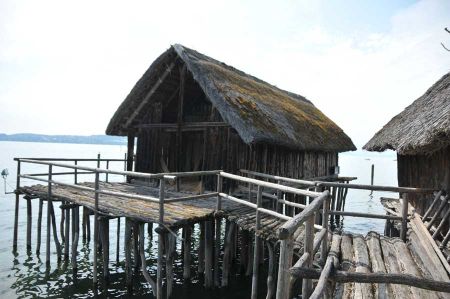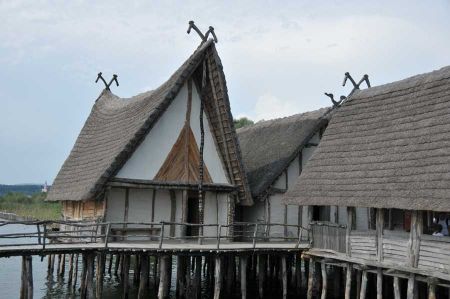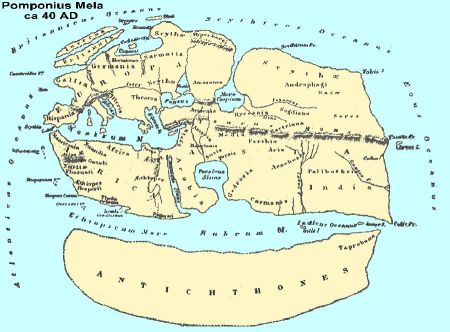Geographer Pomponius Mela and Lake Constance
- Written by Portal Editor
The expansion of the Roman Empire into Anatolia, the Near East and North Africa is partly paralleled by the expansion of the Roman Empire across the Alps.
In the years 16/15 BC, the Roman Alpine campaigns were carried out, in the course of which the entire Lake Constance region was integrated into the Roman Empire. In the course of the campaigns it had even come to a naval battle on Lake Constance.
Comparable to the other regions of their empire, Roman engineers were quick to build their protection castles by surveying the country, building military roads, and establishing their defenses. The construction of the roads was usually done during the campaigns to secure the supplies already. Surveyors and construction workers, mostly consisting of groups of slaves too, formed units that specialized in the construction of roads. One of these surveyors was the Roman geographer Pomponius Mela, who first dealt with Lake Constance, took care of the naming and first survey. His records from the year 43 before Christ describe the lake already as a two-part body of water, the Lacus Venetus as the higher lake and the Lacus Acronius as the lower lake, both of which are traversed by the Rhine.
Pliny the Elder - Lacus Raetiae Brigantinus
For the first time, around the year 75 AD, the naturalist Plinius the Elder describes Lake Constance as Lacus Raetiae Brigantinus, probably because of the important place for the Romans Brigantium (Bregenz), which shortly after received the city rights and later formed the seat of the prefect, too. The name Brigantium probably originally goes back to the here living Celts belonging to the tribe of the so called Brigantier. Here in Brigantium the Roman fleet of Lake Constance was established. With the increasing presence of the Romans, the hills around today's Lindau were populated. Since the shores of Lake Constance were heavily swamped and were again and again flooded by the melt flood, more settlements were built, usually a little higher away from the shore. These includes the cities of Constantia, today's Konstanz and Arbor Felix, today's Arbon.
With the increasing loss of power and the retreat of the Roman Empire to the Rhine border in the course of the 3rd century increasingly Alemanni penetration in the episode, Romans escaped to the north shore of Lake Constance. Part wise, the southern bank of the Alemanni was annexed as a new settlement area. With the increasing Christianization and the founding of the Abbey of Reichenau and the establishment of a bishopric in Constance, the cultural importance of the Lake Constance region increased continuously. The transshipment of goods in German-Italian trade had also brought much boost to the region of Lake Constance. Now Lake Constance has got Latin name, it is called Lacus Potamicus.
Retreat of the Rhine glacier allows Lake Constance
 The origins of Lake Constance date back to the Würm Ice Age. Originally, the Rhine was a huge glacier, which emerged from the alpine Rhine Valley forming the tongue pond, in which today lies Lake Constance. After the ice age, first a large lake, was due to the decline of the Rhine glacier and the continuous erosion of the soil, the lowering of the lake level and the associated separation into two lakes. This process took several thousand years and ensured the drainage of today's Lake Rhine valley. Due to the retreat of the Rhine glacier a colonization by humans became possible. Finds of stone tools point to the first use of the lake shore by humans on the Mesolithic period between 8,000 - 5,500 BC, mostly hunters and gatherers. There are no known traces of settlements from the time.
The origins of Lake Constance date back to the Würm Ice Age. Originally, the Rhine was a huge glacier, which emerged from the alpine Rhine Valley forming the tongue pond, in which today lies Lake Constance. After the ice age, first a large lake, was due to the decline of the Rhine glacier and the continuous erosion of the soil, the lowering of the lake level and the associated separation into two lakes. This process took several thousand years and ensured the drainage of today's Lake Rhine valley. Due to the retreat of the Rhine glacier a colonization by humans became possible. Finds of stone tools point to the first use of the lake shore by humans on the Mesolithic period between 8,000 - 5,500 BC, mostly hunters and gatherers. There are no known traces of settlements from the time.
The first traces of settlement are known from the Neolithic period in the form of pile dwellings as bank settlements. Such wetland settlements could be detected mainly on the Constance Bay, on the Obersee and Überlinger See. There is a well-known museum village consisting of stilt houses at Unteruhldingen, about we will report later. During the Neolithic and the Bronze Age until about 800 BC, more and more shore settlements were created. With the beginning of the Iron Age the settlement changed. With the development of burial mounds, which are mostly protected from agriculture in the forest, a new settlement culture emerges, which is described as the Hallstatt period. The people now settling at Lake Constance are usually of Celtic origin. With the decline of burial mounds culture and the settlement traces are getting thinner. From the so-called Latène period to 450 BC, there are hardly any finds on Lake Constance. Later there are records again from which the groups of settlers on Lake Constance got their name from. This is the term used by the southern shore of the Lake Constance of Helvetii, by heretics in the Alpine Rhine Valley and by Vindelic people in the northeast of the lake. The most important place at that time was the Celtic Brigantion, today Bregenz as well as Konstanz.
Naval battle on Lake Constance - barely imaginable
 After the fall of the Roman Empire with a variety of new settlers on Lake Constance, the dynasty of the Staufer in the region became increasingly powerful and influential. They held their Reichstag on Lake Constance, bringing the Lake Constance an increase in importance again. In Constance, the Hohenstaufern emperor and the representatives of the Lombard League concluded the peace treaty after years of disputes.
After the fall of the Roman Empire with a variety of new settlers on Lake Constance, the dynasty of the Staufer in the region became increasingly powerful and influential. They held their Reichstag on Lake Constance, bringing the Lake Constance an increase in importance again. In Constance, the Hohenstaufern emperor and the representatives of the Lombard League concluded the peace treaty after years of disputes.
Another unimaginable naval battle took place on Lake Constance during the Thirty Years' War, during Austrian troops attempted to repulse Swedish troops who had advanced here.
After the so-called coalition wars between 1798 and 1802, which mainly affected the Lake Constance region, there was a reorganization of state conditions that corresponded to today's ratio.
With a shoreline of 273 kilometres of length of both lakes and 536 square kilometres of seize, Lake Constance is the third largest lake in Central Europe, after Lake Balaton in Hungary and Lake Geneva in Switzerland. About 173 kilometres of shore form the border with Germany, 28 kilometres to Austria and 72 kilometres to Switzerland. The catchment area is approximately 11,500 square kilometres and extends south to Italy. Between Friedrichshafen and Romanshorn the width is 14 kilometres and at its lowest point between Fischbach and Uttwil Lake Constance just measures 254 meters.
The most famous attraction in Lake Constance today, next to the Rhine Falls near Schaffhausen, is located on the island of Mainau with its Mediterranean plants in the castle park. Count Bernadotte described the island as follows:
"She is a coquettish little lady, this Mainau, who always demands great attention, even more love and, above all, incessantly new clothes."
- Lennart Bernadotte
Please read as well:
Everything flows - a saying of the Greek philosopher Heraclitus
Sepp Bögle - the stones-stacker from Radolfzell
